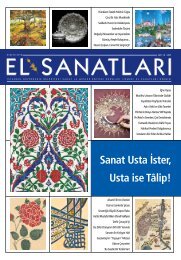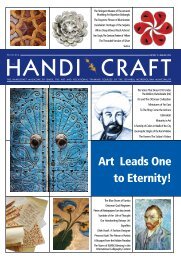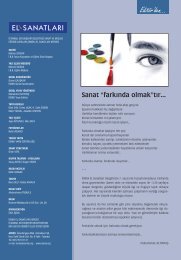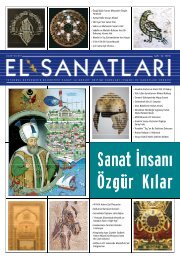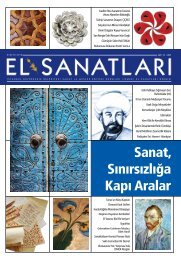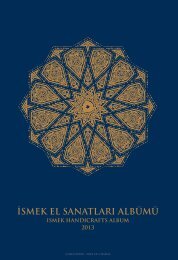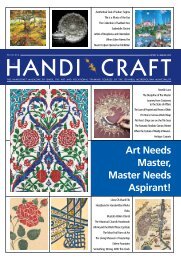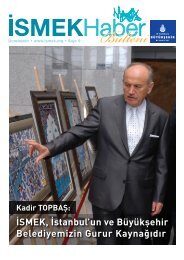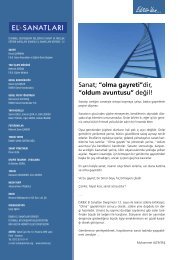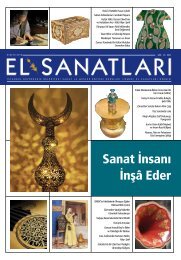Download Link - Ä°SMEK
Download Link - Ä°SMEK
Download Link - Ä°SMEK
Create successful ePaper yourself
Turn your PDF publications into a flip-book with our unique Google optimized e-Paper software.
The first preacher of the mosque was I. Hakkı Bursevi Efendi,<br />
who had a distinguished personality, who was claimed to<br />
perform God given miracles and was the author of a Quran<br />
commentary called Ruhu’l-beyan. He died in 1724, and his<br />
tomb is in the Celvetî Lodge which is around Tuzpazarı in<br />
Bursa. He wrote a myriad of Works. 5 Under the temple and<br />
on Gundoğumu Avenue, there is also a place used to determine<br />
the prayer times during the day. To the left of this<br />
place is a charity Stone. It is written in Mirad-ı Istanbul that<br />
the Rufaian worship services were performed in the mosque.<br />
The architect of this beautiful Tulip Era work is Mehmed Ağa<br />
of Kayseri. Being the master architect of the Tulip Era, he<br />
has other Works both in Istanbul and in Uskudar. He had<br />
replaced Ebu Bekir Ağa, who was the master architect of<br />
Hassa until 1704, but he did not stay in this position for a<br />
long time. in late January 1706, he was replaced by Hacı<br />
Ibrahim Ağa. Being the master architect again in February<br />
3rd, 1709, he built many beautiful works in Istanbul. Among<br />
them, the ones in Uskudar are:<br />
1- The glorious fountain at the Uskudar Pier Square,<br />
2- The Yeni Valide Mosque,<br />
3- The Ahmediye mosque,<br />
4- The Kaptanpasha Mosque, and many other fountains. He<br />
died in 1742, and was buried in the Edirnekapı Cemetary.<br />
He has no gravestones available today. Other than this college,<br />
Ahmet Ağa, who was the Master architect of the Tulip<br />
Era, and Fiduciary Mehmet Ağa, who was called Angel, have<br />
2 other fountains, one being in Uskudar, and the other in<br />
Kasımpaşa. 6<br />
The School Of The Ahmediye Mosque Madrasah<br />
Being one of the premises attached to the Ahmediye College,<br />
the Madrasah is above the Marble yard gate, the fountain,<br />
and the water serving building, which are on Gundoğumu<br />
Avenue. The classroom was built by the Navy Yard Fiduciary<br />
Ahmed Ağa in 1721-22. It served as a school for 182 years,<br />
and then was turned into a lodge by Mahmut Efendi, who<br />
was the Rufaian Imam of the Ahmediye Mosque, and was<br />
a sheikh. Mahmut Efendi died in 1899. 7 For this reason, the<br />
marble yard gate was first called the Madrasah gate, and<br />
then the Lodge gate. Today, one part of the Ahmediye Madrasah<br />
is managed by the District Office in charge of charitable<br />
foundations and is used as an alms house, while another<br />
part is used by the Ministry of Religious Affairs as a Quran<br />
teaching Center. The Madrasah also serves as a dormitory for<br />
50 students. The madrasah consists of 11 rooms which<br />
surround the western and<br />
southern sides of the middle<br />
yard forming an L, and the<br />
classroom above the marble<br />
gate on Gundoğumu Avenue.<br />
Today, all these rooms<br />
which used to host first the<br />
Madrasah students, and<br />
then the dervishes joining<br />
the religious communions and<br />
allusions, serve as classrooms<br />
for students who are trying to<br />
learn and memorize Quran.<br />
The 16-verse history epigraph which is on the marble yard<br />
gate was placed there fort he classroom. The classroom gate<br />
leads to a vaulted hall. The door to the right, and the 2-turn<br />
Stone staircase leads up to the classroom on the top flor.<br />
In front of the 8-cornered and single domed classroom is a<br />
yard with Stone flooring. This yard is blanketed with a porch<br />
with 3 cradle-shaped domes, mounted on the classroom<br />
on both sides, and on elegant marble columns. The column<br />
heads have stalactites. The 5-lined and 10-versed epigraph<br />
prepared by Poet Salim and written with beautiful handwriting<br />
is on the marble arched door.<br />
Cenab-ı sahibu’l-hayat ya’ni el-hac Ahmed kim / Anın nakş-ı<br />
mekin iştiharıdır Eminzade / Hezar ahsenet o merd-i akibet<br />
endiş u agah / Ki olmaz ziynet dihi ruze-i dunyaya dildade<br />
/ Bilub dehrin fenasın da’ima fikr-i muad eyler / Bugunden<br />
hazır eyler zahr u zarın yevm-i miade / Bu beyt-i ilm u fazlı<br />
hasbeten-lillah idub ma’mur / Uluma sa’y iden talibler içun<br />
itdi amade / Salima zeyl-i itmamında nakş itdim bu tarihi / Bu<br />
daru’z-zeyn-i ilmi eyledi tekmil Eminzade.<br />
The classroom is enlightened by 2 rows of Windows, 5<br />
being on the top, and 5 subjacent to the ones on the top<br />
row. Being built totally of hewn Stone, the classroom<br />
also has an alter which is extended outwards, and which<br />
has stalactites on it. To the right of it is a turbine. The designer<br />
of this beautiful complex is Mehmed Ağa of Kayseri.<br />
In front of the domed rooms 5 of which are on the<br />
South and 5 on the east, lies a porch with marble columns,<br />
which is mounted on round archs via diamondshaped<br />
heads. The square shaped madrasah rooms<br />
are equipped with pendanted domes, a a door which<br />
opens to the porch, turbine niches and a chimney. To the<br />
South, where the ablution taps are, a small vaulted piece<br />
of porch which is mounted on 4 marble columns, conjoins<br />
with the classroom. The classroom is situated high<br />
above the entrence gate. There is a porch which mounts<br />
on 6 mukarnas headed marble columns, is blanketed<br />
with cross vaults in the middle, and with domes on the<br />
sides in front of the octagonally planned, arched, low<br />
classroom door which can be reached by climbing stairs.<br />
The 5-lined epigraph on the marble jambed door, which<br />
was prepared by Poet Selim, was written in 1722. In addition<br />
to the entrence and the alter walls in the interior<br />
area, other sides also have Windows one subjacent to<br />
the other. The marble alter is 5-rowed, mukarnased, and<br />
extended outwards.



